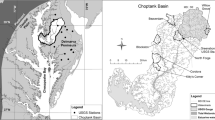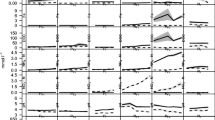Abstract
The fluxes and concentrations ofmaterials from two contiguous second-order watershedsin the Coastal Plain of Maryland, U.S.A. were measuredfor six years prior to and six years subsequent to theformation of a 1.25 ha beaver pond near the bottom ofone of the watersheds. The watersheds have a clayaquiclude and were equipped with V-notch weirs andcontinuous volume-integrating water samplers. Thebeaver pond reduced annual discharge of water,total-N, total-P, dissolved silicate, TOC, and TSS by8, 18, 21, 32, 28, and 27%, respectively. Most ofthe total-N reduction was due to increased retentionof nitrate in the winter and spring and TON in thewinter and summer. Most of the total-P reduction wasthe result of retention of both TPi and TOP in thewinter and summer. Dissolved silicate retentionpeaked in the spring, while TOC and TSS retentionpeaked in the winter. Prior to the formation of thebeaver pond, concentrations of TON, TPi, TOP, TOC, andTSS had highly significant correlations with streamdischarge, especially in the winter, but subsequent tothe pond there was little or no relationship betweenthese concentrations and stream discharge. However,concentrations of nitrate in the spring and ammoniumin the summer were highly correlated with streamdischarge both before and after the formation of thebeaver pond and regressions of discharge versusconcentrations of these nutrients explained more ofthe variation in concentrations after the formation ofthe pond.
Similar content being viewed by others
References
APHA (American Public Health Association) (1989) Standard Methods for the Examination of Water and Wastewater (17th Edn). APHA, Washington DC
Burns DA & McDonnell JJ (1998) Effects of a beaver pond on runoff processes: comparison of two headwaters catchments. J. Hydrol. 205: 248–264
Chirlin GR & Schaffner RW (1977) Observations on the water balance for seven sub-basins of Rhode River, Maryland. In: Correll DL (Ed) Watershed Research in Eastern North America (pp 277–306). Smithsonian Press, Washington DC
Cirmo CP & Driscoll CT (1993) Beaver pond biogeochemistry: acid neutralizing capacity generation in a headwater wetland. Wetlands 13: 277–292
Cirmo CP & Driscoll CT (1996) The impacts of a watershed CaCO3 treatment on stream and wetland biogeochemistry in the Adirondack Mountains. Biogeochem. 32: 265–297
Correll DL & Dixon D (1980) Relationship of nitrogen discharge to land use on Rhode River watersheds. Agro-Ecosyst. 6: 147–159
Correll DL (1981) Nutrient mass balances for the watershed, headwaters intertidal zone, and basin of the Rhode River estuary. Limnol. Oceanogr. 26: 1142–1149
Correll DL, Jordan TE & Weller DE (1994) Long-term nitrogen deposition on the Rhode River watershed. In: Hill P & Nelson S (Eds) Toward a Sustainable Watershed: The Chesapeake Experiment (pp 508–518). Chesapeake Res. Consort. Publ. 149, Edgewater, MD
Correll DL, Jordan TE & Weller DE (1999a) Effects of precipitation and air temperature on phosphorus fluxes from Rhode River watersheds. J. Environ. Qual. 28: 144–154
Correll DL, Jordan TE & Weller DE (1999b) Effects of interannual variation of precipitation on stream discharge from Rhode River subwatersheds. J. Am. Water Resour. Assoc. 35: 1–10
Correll DL, Jordan TE & Weller DE (1999c) Effects of precipitation and air temperature on nitrogen discharges from Rhode River watersheds. Water Air Soil Pollut. 115: 547–575
Correll DL, Jordan TE & Weller DE (1999d) Transport of nitrogen and phosphorus from Rhode River watersheds during storm events. Water Resour. Res. 35: 2513–2521
Devito KJ, Dillon PJ & Lazerte BD (1989) Phosphorus and nitrogen retention by five precambrian shield wetlands. Biogeochemistry 8: 185–204
Gaudy AF & Ramanathan M (1964) A colorimetric method for determining chemical oxygen demand. J. Water Pollut. Control Fed. 36: 1479–1487
Higman D & Correll DL (1982) Seasonal and yearly variation in meteorological parameters at the Chesapeake Bay Center for Environmental Studies. In: Correll DL (Ed) Environmental Data Summary for the Rhode River Ecosystem (pp 1–159). Smithsonian Environmental Research Center, Edgewater, MD
Hodkinson JD (1975) Energy flow and organic matter decomposition in an abandoned beaver pond ecosystem. Oecologia 21: 131–139
Johnston CA & Naiman RJ (1987) Boundary dynamics at the aquatic-terrestrial interface: The influence of beaver and geomorphology. Landscape Ecol. 1: 47–57
Johnston CA, Pinay G, Arens, C & Naiman RJ (1995) Influence of soil properties on the biogeochemistry of a beaver meadow hydrosequence. Soil Sci. Soc. Am. J. 59: 1789–1799
Jordan TE, Correll DL, Weller DE & Goff NM (1995) Temporal variation in precipitation chemistry on the shore of Chesapeake Bay. Water Air Soil Pollut. 83: 263–284
King EJ (1932) The colorimetric determination of phosphorus. Biochem. J. 26: 292–297
Maciolek JA (1962) Limnological Organic Analyses by Quantitative Dichromate Oxidation. US Fish Wildlife Serv. Publ.
Maret TJ, Parker, M & Fannin TE (1987) The effect of beaver ponds on the nonpoint source water quality of a stream in southwestern Wyoming. Wat. Res. 21: 263–268
Martin DF (1972) Marine Chemistry, Vol. 1. Dekker, New York
Naiman RJ, Melillo JM & Hobbie JE (1986) Ecosystem alteration of boreal forest streams by beaver (Castor Canadensis). Ecology 67: 1254–1269
Naiman RJ, Johnston CA & Kelley JC (1988) Alteration of North American streams by beaver. Bioscience 38: 753–762
Naiman RJ, Pinay G, Johnston CA & Pastor J (1994) Beaver influences on the long-term biogeochemical characteristics of boreal forest drainage networks. Ecology 75: 905–921
Peterjohn WT & Correll DL (1986) The effect of riparian forest on the volume and chemical composition of baseflow in an agricultural watershed. In: Correll DL (Ed) Watershed Research Perspectives (pp 244–262). Smithsonian Press, Washington, DC
Smith ME, Driscoll CT, Wyskowski BJ, Brooks CM & Cosentini CC (1991) Modification of stream ecosystem structure and function by beaver (Castor canadensis) in the Adirondack Mountains, New York. Can. J. Zool. 69: 55–61
Strickland JDH & Parsons TR (1972) A Practical Handbook of Seawater Analysis (2nd Edn). Bull. Fish. Res. Bd. Can. 165
Author information
Authors and Affiliations
Rights and permissions
About this article
Cite this article
Correll, D.L., Jordan, T.E. & Weller, D.E. Beaver pond biogeochemical effects in the Maryland Coastal Plain. Biogeochemistry 49, 217–239 (2000). https://doi.org/10.1023/A:1006330501887
Issue Date:
DOI: https://doi.org/10.1023/A:1006330501887




